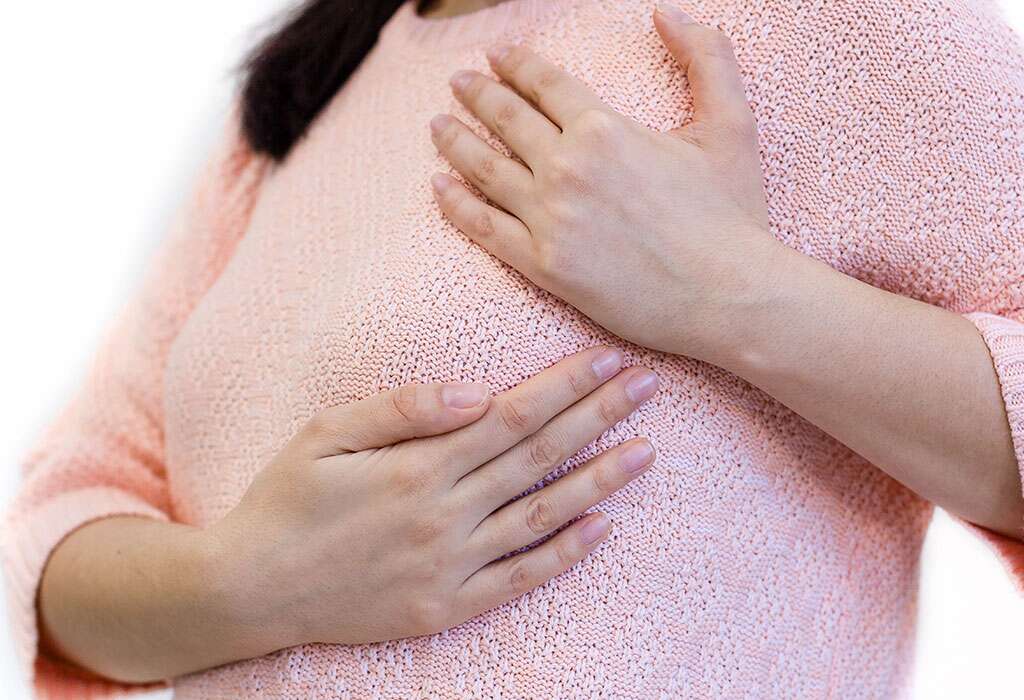
Table of Contents
Being a new mom is not easy as tiredness will be your shadow. The reason for your ill health may not just be sleep-deprived nights. Mastitis is a common condition among breastfeeding moms. One in ten mums develops mastitis while nursing. It is accompanied by breast warmth and pain, infection, and flu-like symptoms if left untreated.
Here’s more on mastitis, the breast infection that almost every nursing mum has. Find ways to spot the condition and a few remedies on how to treat mastitis at home. Also, know when to get in touch with a healthcare provider.
But, What is Mastitis?
Mastitis is the inflammation of breast tissue that can progress into a bacterial infection if not properly treated. It may affect only one breast at a time and occasionally progress onto the other breast.
What are the Causes of Mastitis?
When does breast tissue get affected by mastitis? It starts when your breast milk clogs in a particular area inside your breast. It will keep collecting there and lead to an infection. This condition will worsen if you are engorged persistently. There are also high chances of bacteria entering the breast through the cracked nipples.
There are other causes of mastitis too, such as:
- Oversupply of breastmilk
- Weaning too soon
- Excessive stress on the mind and body
- Pressure on the breasts
What are The Symptoms of Mastitis?
Here’s how you can find out if you have mastitis or not. Keep a lookout for these symptoms:
- Fever
- Decreased milk production in the affected breast
- Exhaustion, chills, aches, and other flu-like symptoms
- A hard lump in the breast tissue
- Discharge from the nipples
- Warmth, redness, swelling, and pain in the breasts
Mastitis comes with a lot of risk factors such as:
- Wearing a tight bra
- Having cracked nipples
- Having had mastitis before
- Smoking
- Poor nutrition
- Improper latching
How to Treat Mastitis at Home: Home Remedies for Mastitis
Symptoms of mastitis may come with no warnings so whenever you feel off, pay attention and get in touch with a lactation consultant or a doctor. There are some quick things you can do if you have mastitis that will prevent it from getting into a serious infection. Home remedies for mastitis can be relied on for the first 24 to 48 hours.
1. Rest
You might feel like you cannot simply rest while having a newborn around but getting some good rest is critical if you have mastitis. Try slowing down the daily grind at least if you cannot rest in bed. Consider asking your partner to take a few days off from work. Breastfeeding can be tough and you need rest to heal.
2. Frequent Breastfeeding
Breastfeeding every two hours during the day is yet another way to cure mastitis in its initial stage. Start with the uncomfortable one but make sure you feed on the breasts so neither of them gets engorged. At the beginning of the feed, babies tend to suck harder which will help dislodge the milk clogs which is basically mastitis. Also, your milk is not affected by mastitis so is safe for the baby to consume.
3. Changing Feeding Positions
You can also change how you hold your baby while nursing them. If you usually use a cradle hold, try side-lying nursing or football hold. Changing the feeding position will change the angle at which the baby sucks the milk. This may help dislodge plugged ducts.
- Lying On The Side
Lie on your side with your baby lying on their side during a nursing session. You could use one hand to hold the baby and the other hand to offer your breast to the baby. Once they latch properly, you can use the free arm to support your head while they either hold the baby close to you.
- Football Hold
Bend your elbow and hold your baby to the side you want to feed first (the affected breast). If you are feeding on your left breast, offer it with your right hand as your guide the baby’s head with your left.
4. OTC Pain Relievers
There are several OTC (over-the-counter) medications for pain, inflammation, and fever such as Advil (ibuprofen) or Tylenol (acetaminophen). These are safe for breastfeeding mums. You could ask your pharmacist or your doctor if you are unsure about which medications to take while nursing. Always read the labels to make sure you are not overdosing.
5. Cabbage Leaves
Here’s how to use cabbage to relieve the pain caused due to mastitis:
- Clean and chill a dry green cabbage. You could cut them into sizes that fit your breast before chilling them in your refrigerator.
- Cover your entire affected breast except for the nipples with the leaves from the chilled cabbage. If it is easier, you could slip the cabbage leaves inside a loose-fitting bra and wear it.
- Keep the cabbage leaves on for till it gets warm or for about 20 minutes.
- Now gently wash your breasts and pat them dry. Toss away the used cabbage leaves and use fresh ones if you are repeating this home remedy for mastitis.
You can repeat this method thrice a day for 20 minutes each time. Cabbage leaves
Cabbage leaves are known to deal with a lot of breastfeeding issues and discomforts. Also, the leaves help in drying up the milk supply.
6. Essential Oils
Studies have shown that essential oils help in treating mastitis. For instance, the compound terpinen-4-ol in tea tree oil has anti-inflammatory, anti-fungal, and anti-bacterial properties. Dilute the oil with a carrier oil such as almond or olive oil and apply it to your breasts.
Tea tree oil can be toxic if swallowed so rinse your breast thoroughly before breastfeeding and keep the bottle away from the reach of babies and children.
7. Breast Massage
Massaging your breasts while nursing is the most effective way to treat mastitis. Start with your thumb and massage in the direction of your nipple right above the affected area. If you are unsure about where the affected area is, feel around your breast for lumps or hard tissues.
If massaging feels good, you may do it even in the shower or bath. You may also try to massage above a blocked duct and then hand express it to relieve blockage or pressure.
8. Garlic
Raw garlic might stimulate the immune system and act as a broad-spectrum antibiotic. The natural benefit of garlic is antimicrobial however, garlic pills you see in a grocery store do not have similar health benefits.
Chop a couple of cloves in your kitchen and swallow them like pills with water, milk, or juice. Swallowing it raw might burn the insides of your mouth and also you might not like its potent flavor.
9. Vitamin C
Research has shown that vitamin C can treat mastitis in cattle. It aids in replenishing antioxidants and healing wounds inside the body. Do pass any supplements prescribed to you medically to make sure they don’t react with each other. Here are some other ways to add vitamin C into your routine:
- Oranges
- Tomatoes
- Cauliflower
- Potatoes
- Brussels sprouts
- Broccoli
- Kiwi
- Red peppers
10. Hydration
Follow the mantra: when in doubt, drink water. Hydrating your body needs to increase significantly when you are nursing. Plenty of water supply for your body will increase the supply of breastmilk. It also means more feeding sessions and more chances to clear clogs and discomfort.
Expert advice during breastfeeding includes drinking plenty of water. Make sure you drink 13 cups of fluids while nursing; it could be milk, soda, coffee, herbal tea, and/or juice.
How to Treat Mastitis at Home: When to See a Doctor?
Home remedies for mastitis are recommended for 1 or 2 days and after that, if you see no healing of the condition, get in touch with a doctor. You might require antibiotics to deal with the infection. Your healthcare provider will prescribe you medication that is safe for nursing women. Here are some warning signs you could look out for:
- Chills and other worsening flu-like symptoms
- Cracked nipples that is a sign of infection
- Swollen, hot, or red breasts
- Red streaks on your breast
- Blood or pus in your breastmilk
- Fever higher than 101℉ (38.3℃)
The Bottom Line: Home Remedies for Mastitis
At the first sign of mastitis, you could do several things. From the above list of home remedies for mastitis, hopefully, some of the tips clear your clogged ducts asap. After 48 hours, if you still see no signs of healing, get in touch with a doctor or a lactation consultant so that they can prescribe you antibiotics.
Antibiotic medication doesn’t mean you have to stop breastfeeding as it will be safe for nursing women. If you think you are prone to frequent bouts of mastitis, make sure you have a toolkit around you.









